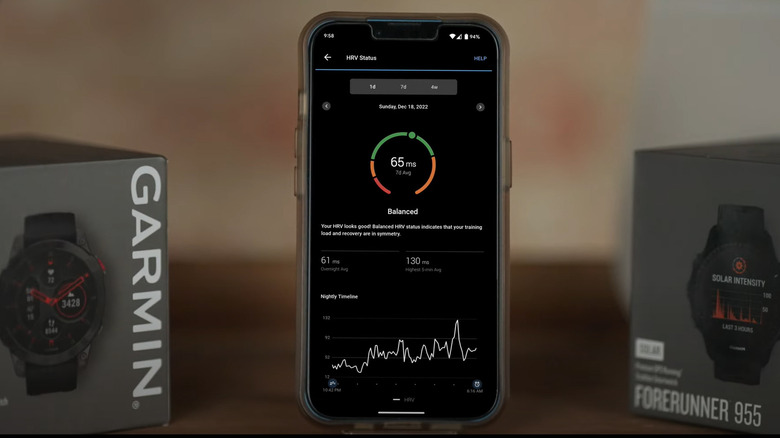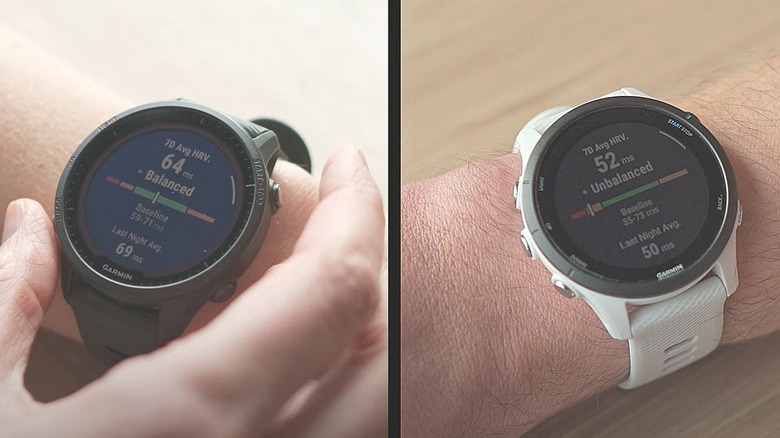What Is 'HRV Status' On Your Garmin Device & What's Considered A Good Score?
Whether you're a fitness buff, an athlete serious about your sport, or are someone hoping to better monitor your health and wellness, regularly wearing a smartwatch comes highly recommended. You can track numerous daily metrics that have to do with the human body, such as the number of steps you've taken, the number of hours you've slept deeply, and how many calories you've burned per logged exercise, among many other things. Depending on what model of smartwatch you have, you may be privy to certain training-related statistics as well, allowing you to monitor how well your body is tolerating your workout regimen. On a Garmin smartwatch, you may see "HRV status" as one of the statistics being tracked.
HRV stands for "heart rate variability," a measurement of the time that elapses between heartbeats, which is known to be in constant fluctuation in a healthy heart. Although the tracked result is miniscule — there are only a few milliseconds between beats — your personal HRV can tell you so much from a training standpoint. Based on an HRV status or score that you can get after a few weeks of consistently wearing your Garmin device, you should be able to tell how well your body is recovering after a hard activity and whether you're ready for more intense workouts.
The HRV status feature is available on several Garmin smartwatch models, namely the Garmin Enduro 2, Garmin Epix and Epix Pro Gen 2, Garmin Fenix 7 and Fenix 7 Pro series, Garmin Instinct 2X Solar, and Garmin Forerunner 255, 265, 955, 965 as well as their smaller and newer iterations. Older Garmin watches may not have the metric available, but may offer the ability to take an HRV stress test using a Garmin chest heart rate monitor, which produces a similar overall stress score.
What makes a good HRV status number on a Garmin watch?
There are many factors that contribute to a person's HRV reading — age, gender, fitness level, sleep quality, and underlying health issues, to name some — all of which are unique to the user. Since every person's heart functions differently, what can be considered a good HRV score by one may not be the same for another. However, when you track your HRV for a significant amount of time using your Garmin watch, you are establishing a baseline scale that can be later used to ensure a healthy HRV reading that is unique to you and your body.
Because HRV is — as the acronym implies — variable by nature, it's recommended that you continue wearing your device overnight for several weeks to create your personal HRV baseline range. Sleep is when the body is doing most of its recovery from the rigors of the day, and tracking during this time ensures that readings are recorded under relatively similar conditions. After the first week, you should be able to view your seven-day HRV average. After three weeks of consistent sleep tracking, all the accumulated data will generate your HRV baseline scale that you can compare against future HRV status readings.
When you navigate to the HRV status widget on a compatible Garmin smartwatch or check the readings on the Garmin Connect app, you should see the result of this comparison in an HRV reading simplified to one of several possible measurement descriptors. You can also see the previous night's average as well as the highest HRV value tracked overnight during any given five-minute period, both of which can give you a better sense of whether your current training load is in sync with your rate of recovery.
Garmin watch HRV status readings, explained
When your seven-day average HRV is within your personal baseline range, you'll see a "Balanced" reading. It means that the amount of stress your body experiences and the time it takes to restore and reboot itself are matching up nicely, indicating that your body is neither overworked nor underutilized.
When your weekly average is a bit above or below your own baseline scale, you may see an "Unbalanced" HRV status. Although a higher HRV usually indicates that your body is thriving under pressure, having an above-average result also means that your body is likely working overtime to appropriately recover from strenuous activity. Similarly, a below-average result can be a sign that you're not handling the bodily stress well enough — you're either exercising too much or are perhaps not getting enough nutrition or quality sleep. Alcohol and caffeine intake can also cause a dip in your HRV weekly average.
When your seven-day HRV status goes way below your personal baseline, you may see a "Low" HRV reading. This could be an exacerbation of a previous below-average HRV result that hasn't improved because your body is still subjected to the same stressors. It could also mean that your body is currently fighting an illness. In any case, developing poor habits will make it harder for you to maintain a healthy HRV score. In fact, if your HRV baseline range drops below the healthy standard for your specific age group, it gets classified as "poor" and won't be displayed on your Garmin watch. Perhaps to encourage you to make better life choices until you're back on track.
How to ensure a good HRV score on your Garmin watch
A properly balanced HRV status requires self-discipline and motivation. While regular exercise is a quick way to boost your overall health and HRV score, overdoing it will do the opposite. An equal amount of workout and rest days in your weekly training plan is recommended to give your body enough time to recuperate. Adequte rest is essential to improved performance as well as HRV status maintenance.
Most of the things you can do to keep your HRV wthin baseline range are ones that you probably often forget or neglect. For instance, getting enough quality sleep has a major impact on bodily recovery. You should also eat a well-balanced diet and stay sufficiently hydrated. While a morning latte or the occasional cocktail or two may affect your HRV, consuming in small amounts shouldn't have too big a negative impact on your score.
You can make up for any HRV deficit you incur by strengthening other positive lifestyle choices. After a night of drinking with friends, try to get extra minutes of sleep and drink more water the next day. Eat something nutritious and if you can, squeeze in a quick 30-minute walk. These things may not bump up your HRV status right away, but they're effective in getting it back to being balanced eventually.
Maintaining a great HRV score is not just about regular physical activity and nourishing your body. Stress comes in many forms and dealing with it using tried-and-true techniques like meditation, deep breathing, and yoga will certainly be beneficial. Emotion regulation is also an important factor — when you have pleasant interactions with people and focus on things that boost your mood, you may find that it has a positive effect on your HRV status and overall well-being.



